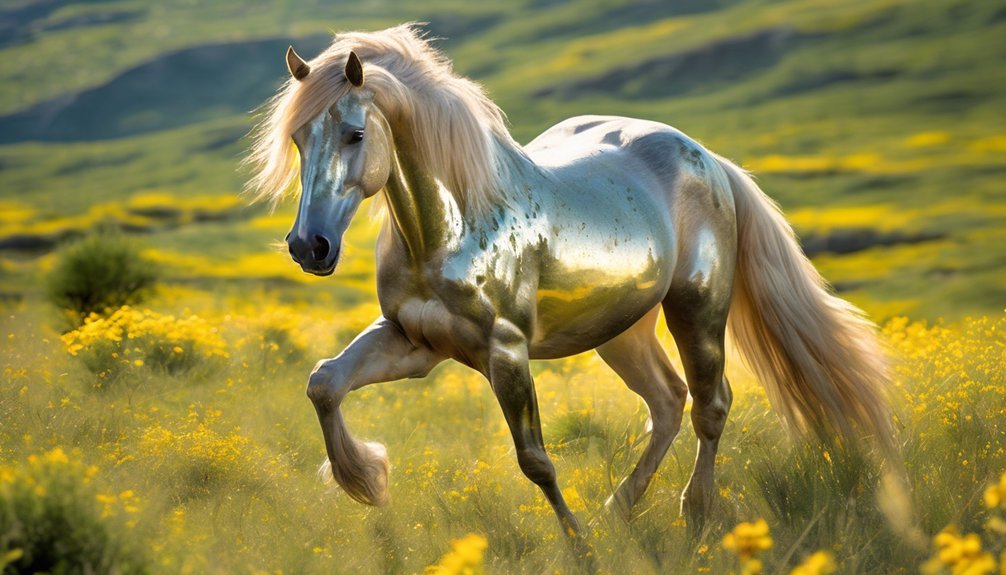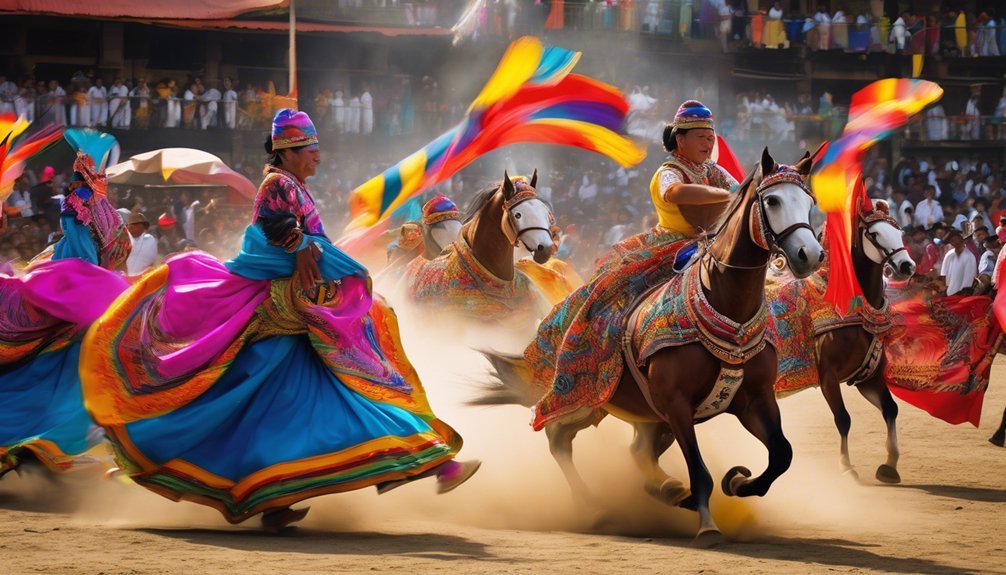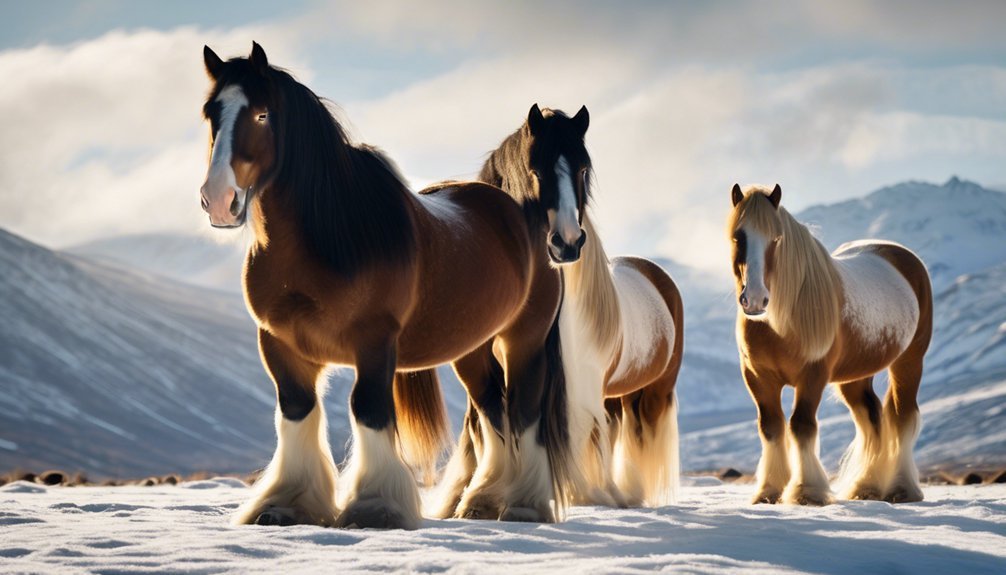
Just as polar bears have evolved to thrive in icy landscapes, some horse breeds are uniquely adapted to survive in cold climates. Their physical traits, like thick coats and stocky builds, provide essential insulation against frigid temperatures. Understanding these adaptations is crucial for anyone interested in equine care or breeding. What specific characteristics make these horses resilient, and how have they evolved to face harsh environments?
Key Takeaways
- Specific breeds like Icelandic and Fjord horses evolved traits such as thick coats and stocky builds to withstand cold climates.
- Adaptations like shorter limbs minimize heat loss, enhancing survival in frigid environments.
- Strong social bonds and herd behaviors provide added protection and warmth through cooperative huddling in harsh conditions.
- Nutritional needs in cold climates require high-energy diets, with quality forage supporting digestion and body temperature maintenance.
- Historical genetic selection favored cold-resilient traits, ensuring these breeds thrive in challenging weather conditions.
The Importance of Adaptation in Cold Environments
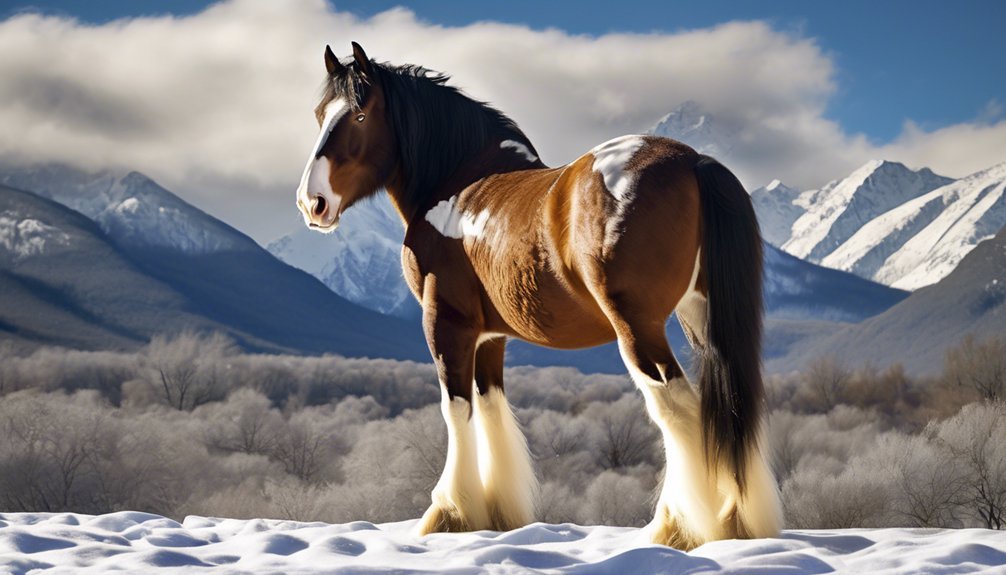
When horses live in cold environments, their ability to adapt becomes crucial for survival and performance. Climate resilience is key, as these animals develop survival strategies that allow them to thrive despite harsh conditions.
For example, they may alter their feeding habits to maximize energy intake from available forage, ensuring they maintain stamina and body heat. Behavioral changes, like seeking shelter or forming herds, help minimize exposure to extreme weather.
Additionally, you might notice that adaptability extends to their social structures, as strong bonds within groups enhance protection. Understanding these mechanisms not only fosters a deeper connection with these magnificent creatures but also informs breeding choices for those interested in enhancing cold climate compatibility in their horses.
Thick Coats and Insulation: Nature's Armor
In cold climates, horses rely on thick coats as a natural insulation mechanism to maintain body heat.
You'll notice variations in coat thickness among different breeds, each adapted to specific weather conditions.
Understanding these adaptations helps you appreciate how nature equips horses for survival in harsh environments.
Natural Insulation Mechanisms
While many animals struggle to stay warm in frigid temperatures, horse breeds adapted to cold climates possess remarkable natural insulation mechanisms. Through natural selection, these horses have developed thick, insulating coats that enhance thermal regulation. This coat traps air, creating a barrier against the cold while allowing moisture to escape.
| Insulation Mechanism | Description | Benefit |
|---|---|---|
| Thick Fur | Dense, long hair | Retains body heat |
| Undercoat | Soft, fluffy layer | Additional warmth |
| Oil Production | Natural oils on skin | Waterproofing and insulation |
These adaptations not only keep them warm but also help them thrive in harsh environments, demonstrating nature's ingenuity in equine survival. When you observe these breeds, you'll appreciate their resilience and beauty.
Adaptations for Cold Weather
Adaptations for cold weather are crucial for horse breeds that thrive in frigid environments, as their thick coats and insulation serve as nature's armor.
These horses develop a dense undercoat and longer guard hairs to trap air and retain body heat, effectively combating the chilling effects of frozen terrain. This natural insulation allows them to remain comfortable while engaging in winter grazing, even when temperatures plummet.
Additionally, certain breeds possess a layer of fat beneath their skin, providing extra warmth and energy reserves.
These adaptations enable these horses to navigate harsh climates, ensuring they can graze and maintain their health throughout the winter months.
With these features, they can endure the cold, showcasing the resilience of nature's design.
Coat Thickness Variations
Thick coats play a vital role in the survival of horse breeds in cold climates. These coats provide essential insulation against freezing temperatures.
As you observe your horse, consider these important aspects:
- Insulation: A thick coat traps warm air close to the skin, keeping your horse comfortable.
- Coat Grooming: Regular grooming helps maintain the coat's health, removing dirt and promoting even growth.
- Seasonal Shedding: As seasons change, your horse sheds its thick winter coat, making room for a lighter summer coat to regulate temperature.
Understanding these elements ensures that you support your horse's natural adaptations, enhancing its well-being in harsh conditions.
Stocky Builds: The Anatomy of Resilience
When you study horse breeds suited for cold climates, you'll notice that their stocky builds play a crucial role in their survival.
These breeds often exhibit body structure adaptations that enhance their strength and stability in harsh conditions.
Coupled with insulating coat features, these anatomical traits ensure they can thrive despite extreme temperatures.
Body Structure Adaptations
Many horse breeds thriving in cold climates exhibit body structure adaptations that enhance their resilience to harsh conditions.
These adaptations focus primarily on body size and muscle density, allowing them to withstand frigid temperatures and physical stress.
Here are three key features:
- Stocky Builds: Compact frames help retain body heat, minimizing energy loss.
- Muscle Density: Greater muscle mass provides strength and endurance, essential for navigating snowy terrains and harsh environments.
- Shorter Limbs: Proportionally shorter legs reduce surface area, further aiding in heat retention and stability on icy ground.
These anatomical traits not only support survival but also contribute to the overall well-being of horses in cold climates, ensuring they thrive despite environmental challenges.
Insulating Coat Features
Adaptations in body structure, such as stocky builds, play a significant role in a horse's ability to thrive in cold climates, but the insulating features of their coats are equally important. Horses develop unique insulating coat characteristics that enhance warmth retention. As temperatures drop, their coats undergo seasonal coat changes, fostering a thicker, denser layer.
| Insulating Coat Characteristics | Seasonal Coat Changes |
|---|---|
| Dense undercoat | Lengthening of guard hairs |
| Water-resistant outer layer | Shedding of summer coat |
| Ability to trap air for warmth | Increased pigmentation in winter |
These features work together to create a robust defense against harsh elements, allowing horses to maintain optimal body temperature even in frigid conditions. Understanding these adaptations helps you appreciate the resilience of cold-climate breeds.
Historical Context: Breeds Developed for Cold Climates
Though horses have roamed various terrains for centuries, specific breeds have emerged in response to the harsh conditions of cold climates. Understanding their historical significance and breed evolution illuminates how these horses adapted to survive.
- Adaptation to Environment: Breeds like the Icelandic and Fjord developed thick coats and sturdy builds to endure frigid temperatures.
- Cultural Importance: These horses often played vital roles in local economies, assisting with transportation and agriculture.
- Genetic Selection: Over generations, selective breeding favored traits that enhanced resilience against cold, leading to distinct physical characteristics.
The Role of Diet in Cold Weather Survival
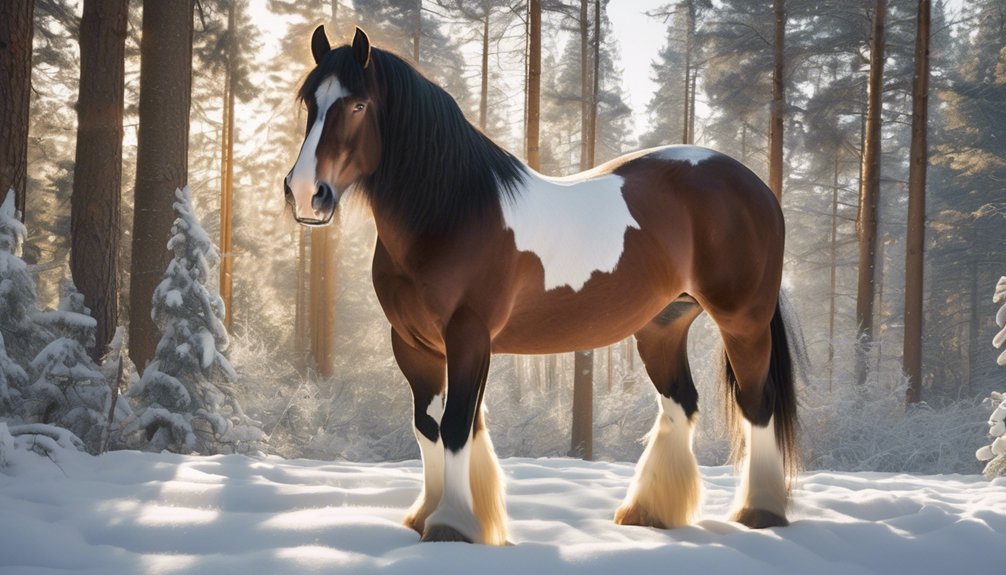
When temperatures drop, the diet of horses in cold climates becomes crucial for their survival and overall health.
To thrive, horses need to meet their nutritional requirements, which include adequate energy, vitamins, and minerals to maintain body heat. Quality forage availability is essential; high-fiber grasses and hay provide the bulk necessary for digestion and warmth.
This forage not only keeps their digestive systems functioning but also helps generate heat through fermentation. You should monitor their body condition, adjusting feed as necessary to ensure they maintain optimal weight.
In extreme cold, consider supplementing their diet with grains or concentrates to provide extra energy, ensuring your horse stays healthy and resilient against harsh weather conditions.
Behavioral Adaptations to Harsh Conditions
Horses in cold climates exhibit several behavioral adaptations that enhance their survival during harsh conditions. These adaptations are crucial in ensuring their well-being and maintaining herd dynamics.
Here are three key social behaviors that you might notice:
- Huddling Together: Horses often group closely to share body heat and shield each other from biting winds.
- Grazing Patterns: They adjust their grazing habits, seeking sheltered areas with better forage availability despite snow cover.
- Vigilant Alertness: Horses display heightened vigilance within their herd, watching for potential threats while reinforcing social bonds.
Understanding these behavioral adaptations helps you appreciate the resilience that horses display in frigid environments, showcasing their instinctual drive to survive and thrive together.
Famous Cold-Weather Breeds and Their Traits
While many breeds thrive in various climates, several have evolved specifically to handle the rigors of cold weather.
Famous cold-weather breeds like the Icelandic horse and the Fjord possess unique traits that enhance their cold resilience. The Icelandic horse, with its thick double coat and sturdy build, is designed for harsh winters, allowing it to thrive in frigid temperatures.
Similarly, the Fjord horse boasts a dense mane and robust muscles, providing both warmth and strength.
Another notable breed, the Shire, is known for its impressive size and heavy feathering, which helps insulate against the cold.
Understanding these breeds and their adaptations can help you appreciate the remarkable ways horses have evolved to survive in challenging environments.
The Impact of Climate Change on Cold-Suited Breeds
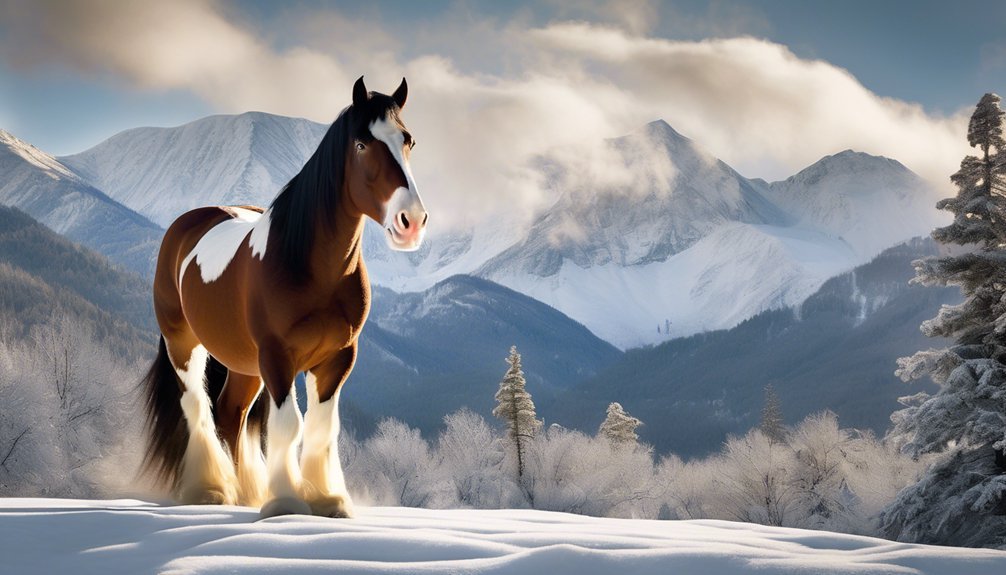
As climate change alters weather patterns and temperatures, cold-suited horse breeds face unprecedented challenges. Understanding the impact of climate variability is crucial for ensuring their survival and welfare.
Here are three key concerns:
- Heat Stress: Increased temperatures can affect breed resilience, leading to health issues and decreased productivity.
- Nutritional Challenges: Shifts in forage availability may require adjustments in feeding practices to maintain their health and energy levels.
- Habitat Loss: Changing ecosystems can threaten the natural environments where these breeds thrive, impacting their ability to adapt.
You'll need to monitor these factors closely to support your cold-suited horses effectively.
Caring for Horses in Cold Weather: Best Practices
To ensure your horses thrive in cold weather, it's essential to implement best care practices that address their unique needs.
Start by providing appropriate cold weather gear, such as blankets and shelter, to protect them from harsh elements. Regularly inspect their coats for any signs of discomfort or damage.
Focus on horse hydration, as horses can become dehydrated even in winter; ensure they've access to fresh, unfrozen water at all times.
Adjust their feeding regimen to include higher-energy diets that help maintain body heat. Additionally, monitor their hooves for ice buildup and consider hoof boots for extra protection.
Frequently Asked Questions
How Do Horse Breeds Adapt to Sudden Temperature Changes?
When facing sudden temperature changes, you'll notice horse breeds utilize coat variations for insulation and temperature regulation. Their thickened fur traps heat, while shedding helps them cool down efficiently, ensuring comfort in fluctuating environments.
Are Cold-Weather Breeds More Prone to Health Issues?
Cold-weather breeds typically show better health resilience, reducing cold sensitivity. However, individual factors like genetics and care can influence their overall health, making it vital for you to monitor any emerging health issues closely.
What Role Does Genetics Play in Cold Climate Adaptation?
Genetic variation significantly influences cold climate adaptation in horses. You'll find that certain breeds develop adaptive traits, like thicker coats and fat reserves, enhancing their survival and performance in harsh environments. Understanding this can deepen your appreciation.
Can Warm-Blooded Horses Thrive in Cold Environments?
Warm-blooded horses can thrive in cold environments, showcasing remarkable resilience. Their temperature tolerance, supported by genetics and adaptability, allows them to acclimate effectively, proving they can endure and flourish despite challenging weather conditions.
How Do Cold Climates Affect Horse Breeding Practices?
Cold climates necessitate careful breeding techniques, emphasizing climate considerations. You'll need to select horses with adaptations for harsh conditions, ensuring their health and performance while promoting resilience in future generations within your breeding program.
Conclusion
In conclusion, while you might think your pampered warm-weather breed can handle a brisk breeze, they'd be as out of place in the snow as a cat in a dog show. Breeds like the Icelandic and Fjord horses flaunt their cold-weather adaptations like badges of honor, proving that nature knows best. So, unless you're keen on outfitting your thoroughbred in a down jacket, it's wise to appreciate the rugged charm of those truly built for the chill.




